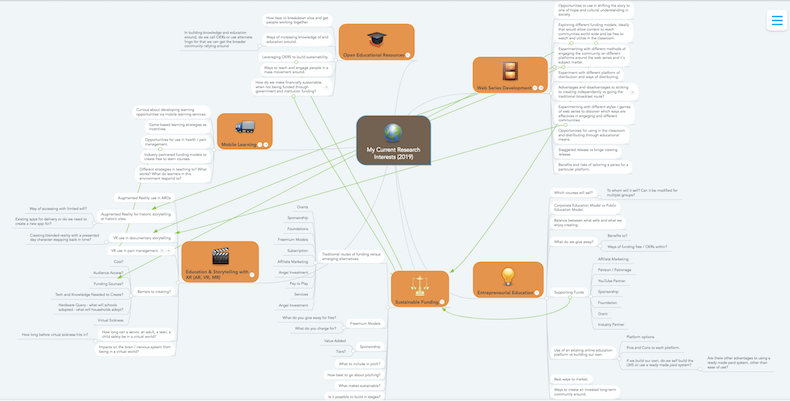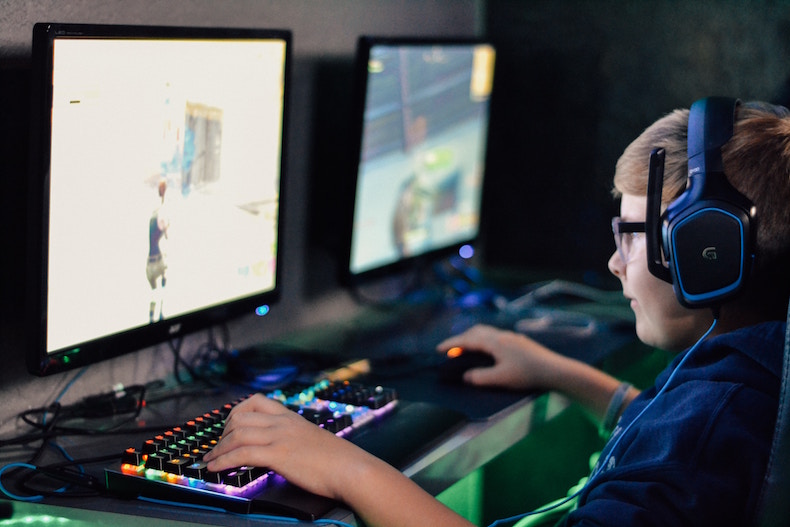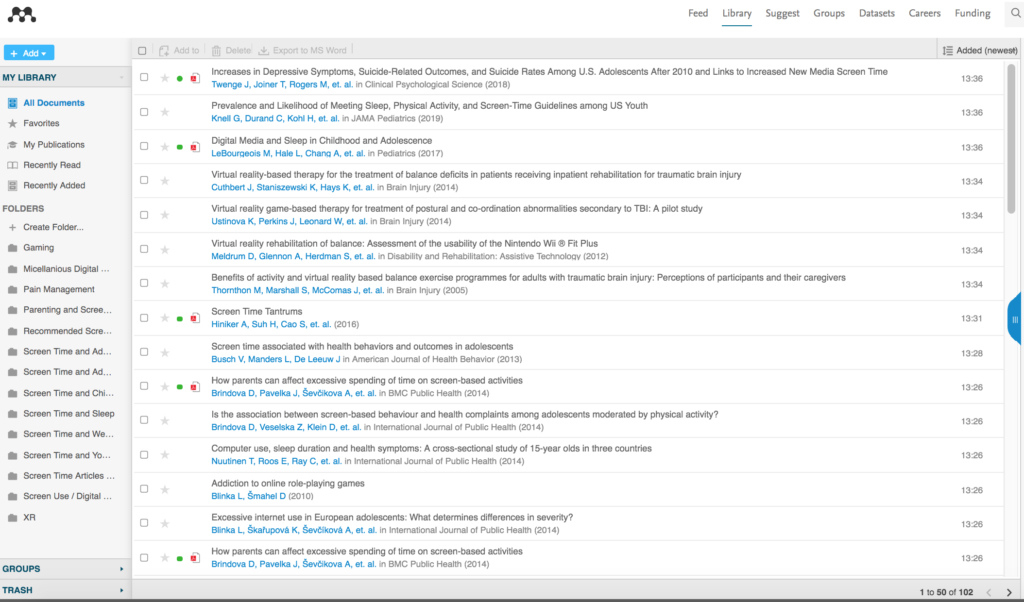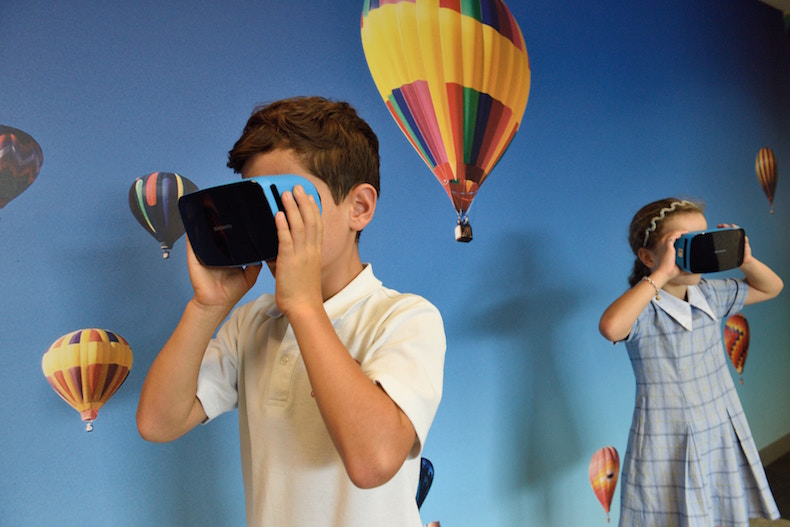As a part of ETEC 500: Research Methodology in Education for my Master of Educational Teachnology, I was asked to experiment with using a citation manager to compile a list of research studies that are relevant to my research area of interest.

For those of you that read my post entitled ‘An Introduction to ETEC 500: Research Methodology in Education, and my Current Research Interests‘, you will remember that my research areas of interest are many and are quite broad. As such I decided to define my search to address an area that has been concerning me from a design perspective around an upcoming educational storytelling piece that my team and I at Ahimsa Media are developing. To explore history immersively around World War II, both in places where history took place and to take that back into classrooms, we are looking at educational technology solutions in AR and VR. As these will create better learning experiences if the users are comfortable in the space, I have been concerned over VR motion sickness and have been attending talks for over a year now, including medical ones, asking questions with regards to ideal times spent in these virtual spaces to limit the likelihood of negative health impacts on the user, like VR motion sickness. Subjectively with the sample size of me, along with anecdotal conversations I have had with people working with virtual reality, it would seem that elements like higher quality filming and the comfort and ease of use of the headset all help in limiting VR motion sickness. But in terms of optimal time limits in the virtual space to limit the impact of those experiences on users and how this differs between age groups and people with different health issues, due to how quickly virtual reality technology has been changing researcher and practitioners still do not have any significant data on this. While this is something that I am continuing to keep a close eye on, so that when creating our storytelling pieces we are creating pieces that are comfortable for the user, it did bring up broader questions for me about screen time in education.
Often what we read in the media, with regards to screen time and youth, are extreme pieces of woe, warning people of screen time perils, or the polar opposite of that, presenting the warnings as the subjective ramblings of people afraid of technological advancements. My own personal believes, from my own experiences of at times excessive screen use, is everything in moderation. Screen based technologies are a part of our lives now, and they come with both positive and negative outcomes. As educators, I feel that one of our roles now is to teach healthy use of those screen based technologies – whether our student is 3 years old, a twenty-something, or over the age of seventy. In order to do that, we also need to gain understanding of optimal screen times for different screen based activities ourselves – whether working on the computer, gaming, watching a video, experiencing a virtual environment …etc. As a classroom teacher, how should I break up the day / activities, so as to not cause adverse health impacts on my students and to teach them to diversify their activities to break up their screen time? What if the classes are intensives on working with screen based technologies – how do I keep student wellbeing top of mind, and teach them healthy screen time skills at the same time? In my case, many of my classes are online, so are entirely screen based – are there ways that I can help remind my students to take digital breaks within that?

These many questions, lead to the query for my research investigation, which is on the ‘Optimal Screen Time Limits for Classroom Activities for Different Screen Based Activities’. As you will see below, most of the research studies I found were driven by health professionals, rather than educators. To focus my findings, I excluded studies that were focused on obesity or violence. A lot of research studies I compiled explore screen time and health and wellbeing, as you will see from the screen shot of the research list that I compiled in Mendeley (the citation manager that I chose to use).

102 papers is A LOT, so I organized the research findings into a number of folders, and focused on the ones that I thought most likely to show evidence of optimal screen times before we spark adverse symptoms in our students from too much screen time. Below is the reference list of research studies, that will hopefully help to answer my query of ‘Optimal Screen Time Limits for Classroom Activities for Different Screen Based Activities’.
REFERENCE LIST (compiled by Erica Hargreave)
Exploring Query on:
Optimal Screen Time Limits for Classroom Activities for Different Screen Based Activities
Screen time and young children: Promoting health and development in a digital world. (2018). Paediatrics & Child Health, 23(1), 83–83. https://doi.org/10.1093/pch/pxx197
Atkin, A. J., Sharp, S. J., Corder, K., & Van Sluijs, E. M. F. (2014). Prevalence and correlates of screen time in youth: An international perspective. American Journal of Preventive Medicine. https://doi.org/10.1016/j.amepre.2014.07.043
Babic, M. J., Morgan, P. J., Plotnikoff, R. C., Lonsdale, C., Eather, N., Skinner, G., … Lubans, D. R. (2015). Rationale and study protocol for “Switch-off 4 Healthy Minds” (S4HM): A cluster randomized controlled trial to reduce recreational screen time in adolescents. Contemporary Clinical Trials. https://doi.org/10.1016/j.cct.2014.12.001
Babic, M. J., Smith, J. J., Morgan, P. J., Eather, N., Plotnikoff, R. C., & Lubans, D. R. (2017). Longitudinal associations between changes in screen-time and mental health outcomes in adolescents. Mental Health and Physical Activity. https://doi.org/10.1016/j.mhpa.2017.04.001
Babic, M. J., Smith, J. J., Morgan, P. J., Lonsdale, C., Plotnikoff, R. C., Eather, N., … Lubans, D. R. (2016). Intervention to reduce recreational screen-time in adolescents: Outcomes and mediators from the ‘Switch-Off 4 Healthy Minds’ (S4HM) cluster randomized controlled trial. Preventive Medicine. https://doi.org/10.1016/j.ypmed.2016.07.014
Blinka, L., Ška?upová, K., Šev?íková, A., Wölfling, K., Müller, K. W., & Dreier, M. (2014). Excessive internet use in European adolescents: What determines differences in severity? International Journal of Public Health. https://doi.org/10.1007/s00038-014-0635-x
Brindova, D., Pavelka, J., Šev?ikova, A., Žežula, I., van Dijk, J. P., Reijneveld, S. A., … Madarasova Geckova, A. (2014). How parents can affect excessive spending of time on screen-based activities. BMC Public Health, 14(1), 1261. https://doi.org/10.1186/1471-2458-14-1261
Brindova, D., Veselska, Z. D., Klein, D., Hamrik, Z., Sigmundova, D., van Dijk, J. P., … Geckova, A. M. (2014). Is the association between screen-based behaviour and health complaints among adolescents moderated by physical activity? International Journal of Public Health. https://doi.org/10.1007/s00038-014-0627-x
Busch, V., Manders, L. A., & De Leeuw, J. R. J. (2013). Screen time associated with health behaviors and outcomes in adolescents. American Journal of Health Behavior. https://doi.org/10.5993/AJHB.37.6.11
Domingues-Montanari, S. (2017). Clinical and psychological effects of excessive screen time on children. Journal of Paediatrics and Child Health. https://doi.org/10.1111/jpc.13462
Duch, H., Fisher, E. M., Ensari, I., & Harrington, A. Screen time use in children under 3 years old: A systematic review of correlates. , 10 § (2013).
Ferguson, C. J. (2017). Everything in Moderation: Moderate Use of Screens Unassociated with Child Behavior Problems. Psychiatric Quarterly. https://doi.org/10.1007/s11126-016-9486-3
Fitzpatrick, C., Burkhalter, R., & Asbridge, M. (2019). Adolescent media use and its association to wellbeing in a Canadian national sample. Preventive Medicine Reports. https://doi.org/10.1016/j.pmedr.2019.100867
Friedrich, R. R., Polet, J. P., Schuch, I., & Wagner, M. B. (2014). Effect of intervention programs in schools to reduce screen time: A meta-analysis. Jornal de Pediatria. https://doi.org/10.1016/j.jped.2014.01.003
Grøntved, A., Singhammer, J., Froberg, K., Møller, N. C., Pan, A., Pfeiffer, K. A., & Kristensen, P. L. (2015). A prospective study of screen time in adolescence and depression symptoms in young adulthood. Preventive Medicine. https://doi.org/10.1016/j.ypmed.2015.08.009
Guernsey, L. (n.d.). Into The Minds Of Babes: How Screen Time Affects Children From Birth To Age Five. Retrieved from www.naeyc.org
Hamer, M., Stamatakis, E., & Mishra, G. D. (2010). Television- and Screen-Based Activity and Mental Well-Being in Adults. American Journal of Preventive Medicine. https://doi.org/10.1016/j.amepre.2009.12.030
Herman, K. M., Hopman, W. M., & Sabiston, C. M. (2015). Physical activity, screen time and self-rated health and mental health in Canadian adolescents. Preventive Medicine. https://doi.org/10.1016/j.ypmed.2015.01.030
Hinkley, T., Salmon, J., Okely, A. D., & Crawford, D. (2013). The correlates of preschoolers’ compliance with screen recommendations exist across multiple domains. Preventive Medicine. https://doi.org/10.1016/j.ypmed.2013.05.020
Iannotti, R. J., Kogan, M. D., Janssen, I., & Boyce, W. F. (2009). Patterns of Adolescent Physical Activity, Screen-Based Media Use, and Positive and Negative Health Indicators in the U.S. and Canada. Journal of Adolescent Health. https://doi.org/10.1016/j.jadohealth.2008.10.142
Jongenelis, M. I., Scully, M., Morley, B., Pratt, I. S., & Slevin, T. (2018). Physical activity and screen-based recreation: Prevalences and trends over time among adolescents and barriers to recommended engagement. Preventive Medicine. https://doi.org/10.1016/j.ypmed.2017.10.006
Keane, E., Kelly, C., Molcho, M., & Nic Gabhainn, S. (2017). Physical activity, screen time and the risk of subjective health complaints in school-aged children. Preventive Medicine. https://doi.org/10.1016/j.ypmed.2016.12.011
Kremer, P., Elshaug, C., Leslie, E., Toumbourou, J. W., Patton, G. C., & Williams, J. (2014). Physical activity, leisure-time screen use and depression among children and young adolescents. Journal of Science and Medicine in Sport. https://doi.org/10.1016/j.jsams.2013.03.012
Lissak, G. (2018). Adverse physiological and psychological effects of screen time on children and adolescents: Literature review and case study. Environmental Research. https://doi.org/10.1016/j.envres.2018.01.015
Madhav, K. C., Sherchand, S. P., & Sherchan, S. (2017). Association between screen time and depression among US adults. Preventive Medicine Reports. https://doi.org/10.1016/j.pmedr.2017.08.005
Maniccia, D. M., Davison, K. K., Marshall, S. J., Manganello, J. A., & Dennison, B. A. (2011). A Meta-analysis of Interventions That Target Children’s Screen Time for Reduction. PEDIATRICS. https://doi.org/10.1542/peds.2010-2353
Maras, D., Flament, M. F., Murray, M., Buchholz, A., Henderson, K. A., Obeid, N., & Goldfield, G. S. (2015). Screen time is associated with depression and anxiety in Canadian youth. Preventive Medicine. https://doi.org/10.1016/j.ypmed.2015.01.029
Marques, A., Calmeiro, L., Loureiro, N., Frasquilho, D., & de Matos, M. G. (2015). Health complaints among adolescents: Associations with more screen-based behaviours and less physical activity. Journal of Adolescence. https://doi.org/10.1016/j.adolescence.2015.07.018
Martin, K. (2011). Electronic Overload: The Impact of Excessive Screen Use on Child and Adolescent Health and Wellbeing.
Ponti, M. (2019). Digital media: Promoting healthy screen use in school-aged children and adolescents. Retrieved from Canadian Paediatric Society website: https://www.cps.ca/en/documents/position/digital-media
Ponti, M., Bélanger, S., Grimes, R., Heard, J., Johnson, M., Moreau, E., … Williams, R. (2017). Screen time and young children: Promoting health and development in a digital world. Paediatrics & Child Health, 22(8), 461–468. https://doi.org/10.1093/pch/pxx123
Przybylski, A. K., & Weinstein, N. (2017). A Large-Scale Test of the Goldilocks Hypothesis: Quantifying the Relations Between Digital-Screen Use and the Mental Well-Being of Adolescents. Psychological Science. https://doi.org/10.1177/0956797616678438
Przybylski, A. K., & Weinstein, N. (2019). Digital Screen Time Limits and Young Children’s Psychological Well-Being: Evidence From a Population-Based Study. Child Development. https://doi.org/10.1111/cdev.13007
Ralph, R., & Petrina, S. (2018). Social Learning with Mobile Devices in Preschool Classrooms. European Journal of STEM Education, 3(3). https://doi:10.20897/ejsteme/3872
Radesky, J. S., Schumacher, J., & Zuckerman, B. (2014). Mobile and interactive media use by young children: The good, the bad and the unknown | EurekAlert! Science News. Pediatrics. https://doi.org/10.1542/peds.2014-2251
Ramirez, E. R., Norman, G. J., Rosenberg, D. E., Kerr, J., Saelens, B. E., Durant, N., & Sallis, J. F. (2011). Adolescent screen time and rules to limit screen time in the home. Journal of Adolescent Health. https://doi.org/10.1016/j.jadohealth.2010.07.013
Ramsey Buchanan, L., Rooks-Peck, C. R., Finnie, R. K. C., Wethington, H. R., Jacob, V., Fulton, J. E., … Glanz, K. (2016). Reducing Recreational Sedentary Screen Time: A Community Guide Systematic Review. American Journal of Preventive Medicine. https://doi.org/10.1016/j.amepre.2015.09.030
Saunders, T. J., & Vallance, J. K. (2017). Screen Time and Health Indicators Among Children and Youth: Current Evidence, Limitations and Future Directions. Applied Health Economics and Health Policy. https://doi.org/10.1007/s40258-016-0289-3
Schaan, C. W., Cureau, F. V., Sbaraini, M., Sparrenberger, K., Kohl, H. W., & Schaan, B. D. (2019). Prevalence of excessive screen time and TV viewing among Brazilian adolescents: a systematic review and meta-analysis. Jornal de Pediatria. https://doi.org/10.1016/j.jped.2018.04.011
Shiue, I. (2015). Duration of daily TV/screen watching with cardiovascular, respiratory, mental and psychiatric health: Scottish Health Survey, 2012-2013. International Journal of Cardiology. https://doi.org/10.1016/j.ijcard.2015.03.259
Smith, L., Louw, Q., Crous, L., & Grimmer-Somers, K. (2009). Prevalence of neck pain and headaches: Impact of computer use and other associative factors. Cephalalgia. https://doi.org/10.1111/j.1468-2982.2008.01714.x
Swartz, M. K. (2017). Taking Another Look at Screen Time for Young Children. Journal of Pediatric Health Care. https://doi.org/10.1016/j.pedhc.2017.01.006
Taehtinen, R. E., Sigfusdottir, I. D., Helgason, A. R., & Kristjansson, A. L. (2014). Electronic screen use and selected somatic symptoms in 10-12 year old children. Preventive Medicine. https://doi.org/10.1016/j.ypmed.2014.07.017
Torsheim, T., Eriksson, L., Schnohr, C. W., Hansen, F., Bjarnason, T., & Välimaa, R. (2010). Screen-based activities and physical complaints among adolescents from the Nordic countries. BMC Public Health. https://doi.org/10.1186/1471-2458-10-324
Twenge, J. M., & Campbell, W. K. (2018). Associations between screen time and lower psychological well-being among children and adolescents: Evidence from a population- based study. Preventive Medicine Reports. https://doi.org/10.1016/j.pmedr.2018.10.003
Wahi, G., Parkin, P. C., Beyene, J., Uleryk, E. M., & Birken, C. S. (2011). Effectiveness of interventions aimed at reducing screen time in children: A systematic review and meta- analysis of randomized controlled trials. Archives of Pediatrics and Adolescent Medicine. https://doi.org/10.1001/archpediatrics.2011.122
Wang, C., Li, K., Kim, M., Lee, S., & Seo, D. C. (2019). Association between psychological distress and elevated use of electronic devices among U.S. adolescents: Results from the youth risk behavior surveillance 2009-2017. Addictive Behaviors. https://doi.org/10.1016/j.addbeh.2018.10.037
Zhao, J., Zhang, Y., Jiang, F., Ip, P., Ho, F. K. W., Zhang, Y., & Huang, H. (2018). Excessive Screen Time and Psychosocial Well-Being: The Mediating Role of Body Mass Index, Sleep Duration, and Parent-Child Interaction. Journal of Pediatrics. https://doi.org/10.1016/j.jpeds.2018.06.029
Zink, J., Belcher, B. R., Kechter, A., Stone, M. D., & Leventhal, A. M. (2019). Reciprocal associations between screen time and emotional disorder symptoms during adolescence. Preventive Medicine Reports. https://doi.org/10.1016/j.pmedr.2019.01.014
If you have a research study that you think I should add to this list, please add it in the comments below. I would also love to hear in the comments below, if you have ways to maintain healthy screen time limits, either in your classroom or within your life and work.
Oh, and if you would like any of the lists of research studies that I have begun to compiled please shoot me an email via my ‘Contact Page‘.


It was so helpful! Thanks for all the work you’re putting in.
My pleasure.